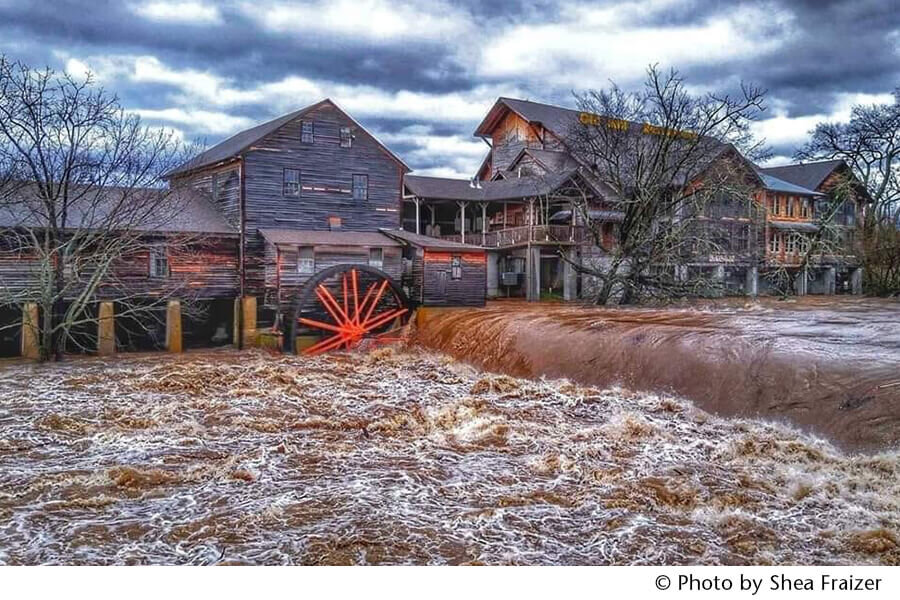The Old Mill: 200 years of flooding, and still standing strong
Last month — February, 2020 — the waters of the Little Pigeon River poured over its banks, swirling around the original stone pillars that have held The Old Mill intact for 190 years.
We all got a little nervous thinking back to February 23, 2019 of last year, when we witnessed rainfalls so heavy that spectators posted the footage with their I-phones of the raging river as it gushed by the mill. Some of those videos exceeded one million views. Even though we escaped any significant damage, this area hasn’t always been so lucky.
On that same date in 1875, floodwaters spread more than three-quarters of a mile wide and rose to 20 feet, carrying barns, houses, businesses, and nearly everything else in its path downriver. The massive breast wheel on the front of the mill was washed away, along with the wooden covered bridge next to it.
On April 1, 1920, at about midnight, another flood-ravaged Pigeon Forge, taking the second water wheel off the mill and the steel bridge that had replaced the wooden one. It took about six months to replace the bridge again, this time with a concrete structure with very low walls on the sides, most likely in hopes that if the water rose again, it would simply wash over the bridge and leave it standing.
Taking steps to avert disaster
Such are the occupational hazards that come with running a gristmill that relies on water for turning the stones that grind the grains. Being perched right next to its power source, the mill typically witnesses some kind of flooding about twice a year or more, and we take it seriously each time.
When needed, we close the mill and store for as long as it takes to make sure that it is safe for staff and visitors. Usually, that’sjust for a day or two, as was the case this time. First, we have to wait for all the waters to recede back to the normal flow. Then the millers check out the pin stock (the chamber that the dam diverts water into) to remove large branches or anything else that could have washed in over the turbine. They survey underneath the structure to make sure that the pillars are still sound and look for anything that could affect operations.
Giving the large breast wheel a few slow turns is important, too. If it’s off just a little bit, it could do damage to the mill and affect the elevators inside that carry grains up and down the three floors. They don’t want any surprises when starting up the stones which weigh more than 4,000 pounds.
Hunting for pieces of history
One of the less obvious things that the millers like about this process are the opportunity to go exploring to see what has washed in, and what has been uncovered as rocks and sediment wash out. After each flood, the topography changes along the millpond and under the mill. They will usually find old bricks, remains of wooden pillars, and gnarly chunks of molten iron, or slag, leftover from the iron forge that was established more than 200 years ago before the mill was built. Several years ago, we commissioned the University of Tennessee to conduct an official archeological dig to help us piece together clues such as these to determine the original layout of the iron forge and the sawmill that once stood here.
Our old mill has endured nearly two centuries of flooding, supported a growing farming community that would turn into one of the country’s most visited areas, played its part in a war that was far less civil than its name suggests, served as the first post office and first power and light company, and sustained the seven different families who have called it their own. Most important of all, it has been a constant in a changing world.
For all the challenges Mother Nature has thrown its way, it’s pretty amazing that The Old Mill still operates very much as it did when it first began.




